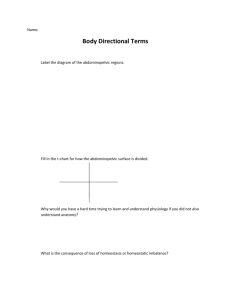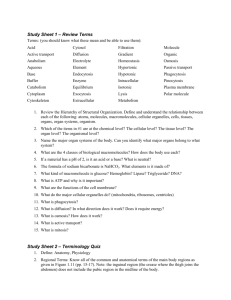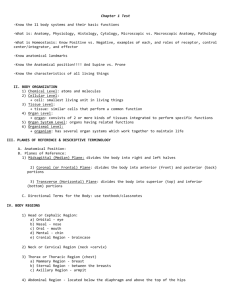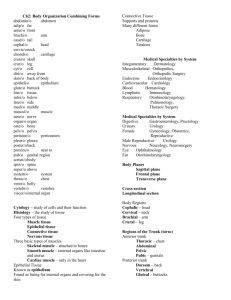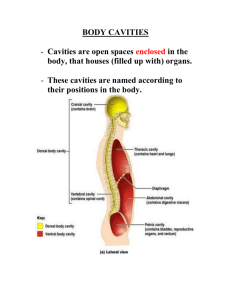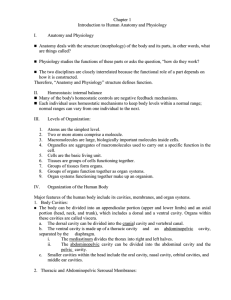Chapter 1 Lecture: The Human Body – An Orientation
advertisement
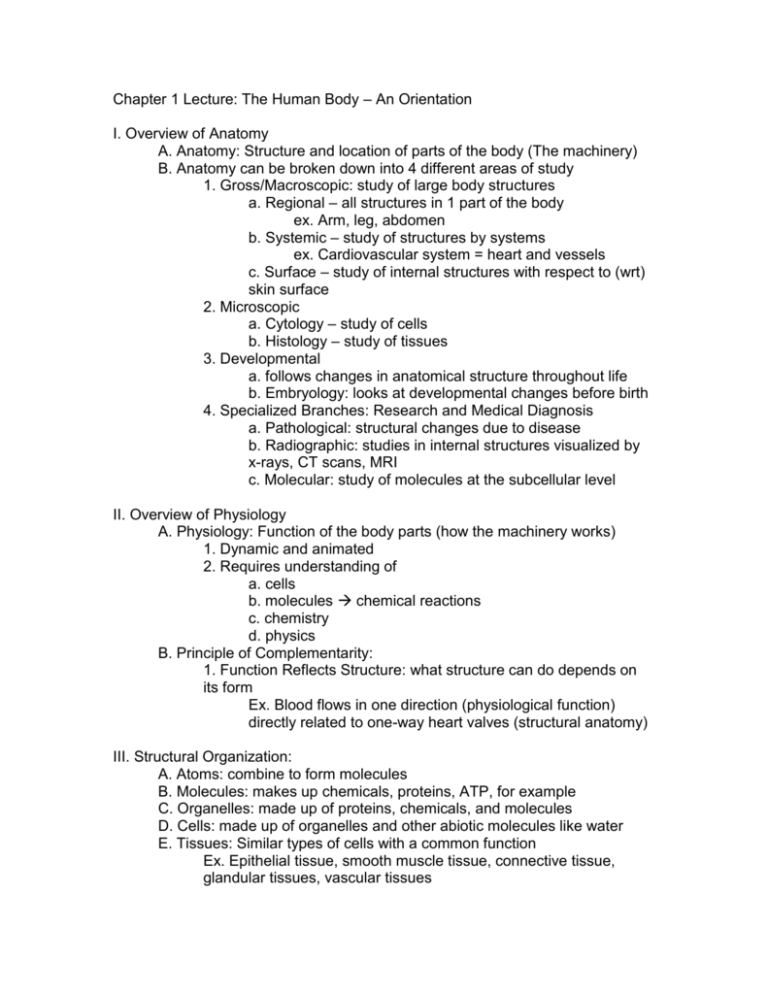
Chapter 1 Lecture: The Human Body – An Orientation I. Overview of Anatomy A. Anatomy: Structure and location of parts of the body (The machinery) B. Anatomy can be broken down into 4 different areas of study 1. Gross/Macroscopic: study of large body structures a. Regional – all structures in 1 part of the body ex. Arm, leg, abdomen b. Systemic – study of structures by systems ex. Cardiovascular system = heart and vessels c. Surface – study of internal structures with respect to (wrt) skin surface 2. Microscopic a. Cytology – study of cells b. Histology – study of tissues 3. Developmental a. follows changes in anatomical structure throughout life b. Embryology: looks at developmental changes before birth 4. Specialized Branches: Research and Medical Diagnosis a. Pathological: structural changes due to disease b. Radiographic: studies in internal structures visualized by x-rays, CT scans, MRI c. Molecular: study of molecules at the subcellular level II. Overview of Physiology A. Physiology: Function of the body parts (how the machinery works) 1. Dynamic and animated 2. Requires understanding of a. cells b. molecules chemical reactions c. chemistry d. physics B. Principle of Complementarity: 1. Function Reflects Structure: what structure can do depends on its form Ex. Blood flows in one direction (physiological function) directly related to one-way heart valves (structural anatomy) III. Structural Organization: A. Atoms: combine to form molecules B. Molecules: makes up chemicals, proteins, ATP, for example C. Organelles: made up of proteins, chemicals, and molecules D. Cells: made up of organelles and other abiotic molecules like water E. Tissues: Similar types of cells with a common function Ex. Epithelial tissue, smooth muscle tissue, connective tissue, glandular tissues, vascular tissues F. Organs: composed of two or more tissue types performing a specific function Ex. Stomach: G. Organ systems: several organs working together to accomplish a common purpose Ex. Digestive: esophagus, stomach, small and large intestine, liver, pancreas. H. Organism level IV. Body Systems A. Integumentary system: body coverings– skin, hair, nails, sweat glands 1. protection 2. regulates body temp 3. environmental sensors 4. makes vitamin D B. Skeletal system: Bones, cartilage, ligament and joints 1. provides muscles framework 2. protects organs 3. form blood cells 4. stores minerals like calcium C. Muscular system: muscles and tendons 1. contraction (shortening) of muscles causing motion 2. maintains posture D. Nervous system: brain, spinal cord, nerves, sensory receptors. 1. detects changes internally and externally 2. processes incoming information and directs response 3. responds to env’t by activating glands/muscles E. Endocrine system: glands, hormones 1. regulatory system Ex. Metabolism, growth, reproduction 2. Synchronizes all body systems F. Cardiovascular system: heart and blood vessels 1. transports gases, chemicals, white blood cells that fight infection 2. transports nutrients, eliminates waste G. Lymphatic system: lymph nodes, vessels, red bone marrow, thymus, spleen 1. involved in immune response a. Disposes of pathogens and debris b. houses lymphocytes (wbc) 2. return fluids in tissues to the blood vessels H. Respiratory system: nose, pharynx, larynx, trachea, lungs, diaphragm 1. supplies body with oxygen, removing carbon dioxide I. Digestive system: mouth, esophagus, stomach, intestines, liver, and other glands 1. break down food and deliver nutrients to body tissues 2. eliminates indigestible food J. Urinary systems: kidneys, ureters, bladder, urethra 1. removing wastes from the blood stream and flush from body. 2. maintains water, electrolytes, and pH balance of body K. Reproductive system: production of offspring V. Characteristics of life A. Functional characteristics: Organ systems do not work in isolation. They work cooperatively and have inter-relationships. 1. Maintaining Boundaries: every organism makes internal env’t distinct from external one a. cellular level: p. membrane b. organismal level: skin/integument 2. Movement: locomotion, propulsion through internal organs (peristalsis) a. contractility (cellular level): shortening of muscle cells b. ex. of inter-relationship: skeletal, muscular systm 3. Responsiveness/Irritability: sense change in env’t (stimuli) and react a. ex. of inter-relationship: nerve cells of nervous systm (highly irritable), skeletal, muscular sytm 4. Digestion: food broken down into simpler forms: macromolecules, and absorbed by cells a. ex. of inter-relationship: digestive and circulatory systems 5. Metabolism: sum of all chemical rxns in body a. catabolism: breaking down of substances (via dehydration synthesis, bond breaking, energy release) b. anabolism: building of substances (via hydrolysis, bond forming, energy stored) c. cellular respiration: converting food energy into ATP, using oxygen d. ex. of inter-relationship: hormones of endocrine system, circulatory systm 6. Excretion: removal of waste produced during digestion and metabolism a. ex. of inter-relationship: digestive and respiratory systms 7. Reproduction: making new individual at 2 levels a. cellular level: by mitosis followed by cytokinesis, for growth and repair. Produces more cells. b. organismal level: union of sperm and egg 8. Growth: increasing in body part or overall size of organism B. Survival Needs 1. Nutrients (via diet): chemical substances for energy and cell building 2. Oxygen: to release energy from foods via cellular respiration. 3. Water: Provides env’t for chemical reactions and excretion 4. Proper body temperature: to maintain chemical reactions. a.Too low – chemical rxns slow b. Too high – changes shape of proteins (denaturization), which causes them to be non-functional c. heat generated by muscles 5. Atmospheric pressure: force air exerts on the body. a. influence gas exchange, breathing VI. Homeostasis (use Venn diagram in intNB – student correct or add to own diagram) A. Maintenance of a relatively stable internal environment (w/in ranges) in an ever-changing external env’t 1. dynamic state of equilibrium B. Accomplished by communication within body via 2 systems 1. nervous system: detecting changes through nerve/electrical impulses 2. endocrine system: glands release hormones that communicate between organ systems and react to change C. Homeostasis controlled by 1. receptors: detect change (stimuli) and send information (input) to the control center 2. control center (brain): determines set-point to be maintained. Determines course of action. 3. effector: the organ or structure that responds to the stimulus and either reverses it or enhances it. D. Two forms of Homeostatic Control 1. Negative Feedback: the effect of the response is to reverse the original stimulus. a. Examples: body temperature: -. if too high – blood vessels dilate, body sweats to release heat - if too low – blood vessels constrict into the body, goose bumps conserve heat. 2. Positive Feedback: effect of the response is to continue the original stimulus a. Examples - Reward sytm in school - Labor contractions due to oxytocin - Blood clotting: platelets release chemicals that attract more platelets E. Homeostatic imbalance = disease 1. Aging decreases ability to maintain homeostasis VII. Language of Anatomy A. Anatomical position: 1. body erect 2. palms forward, thumbs away 3. feet slightly apart 4. R is always the specimen’s right side. B. Body Regions 1. Axial: main axis of the body – head, neck, trunk of body 2. Appendicular – limbs & attachments C. Orientation & Direction 1. Superior: upper, or above something 2. Inferior: lower, or below something 3. Anterior or Ventral: front, in front of, or belly 4. Posterior or Dorsal: after, behind, toward the rear, back 5. Medial: toward the mid-line, middle, away from the side 6. Lateral: toward the side of the body - away from the mid-line 7. Proximal: toward or near the trunk of the body, near the point of attachment to the body 8. Distal: away from, farther from the origin or attachment to the body 9. Cranial: towards head of the body 10. Caudal: towards feet 11. Superficial: external, near the body surface 12. Deep: internal, away from the body surface D. Body Landmarks 1. Anterior a. Abdominal b. Antebrachial: forearm c. Antecubital: anterior elbow surface d. Axillary: armpit e. Brachial: arm f. Carpal: wrist g. Cervical: neck region h. Coxal: hip i. Digital: fingers/toes j. Femoral: thigh k. Frontal: forehead l. Inguinal: groin m. Mammary: breast n. Mental: chin o. Nasal: nose p. Oral: mouth q. Orbital: eye socket r. Patellar: kneecap s. Pelvic: pelvis t. Fibular: side of leg u. Pubic: genital region v. Sternal: breast bone w. Tarsal: ankle x. Thoracic: chest y. Umbilical: navel 2. Posterior – a. Acromial: point of shoulder b. Calcaneal: heel of foot c. Cephalic: head d. Dorsum: back e. Gluteal: buttocks f. Lumbar: back between ribs & hips g. Manus: hand h. Occipital: base of skull i. Olecranal: posterior of elbow j. Otic: ear k. Plantar: sole of the foot l. Popliteal: back of knee m. Sacral: between hips on back n. Scapular: shoulder blade o. Sural: calf (back of leg) p. Vertebral: spinal column E. Body Planes: 1. to see internal structure of organs 2. refers to any slice or cut through a three-dimensional structure, allowing us to visualize relationships between those parts. CT and MRI technology use these principles. a. Sagittal: divides the body or organ vertically into R and L i. Midsagittal: divides the body or organ vertically into equal right and left parts ii. Parasagittal: vertical division offset from midline b. Frontal/Coronal: a vertical plane dividing the body or an organ into anterior (front) and posterior (back) sections. c. Transverse/Horizontal/Cross Section: a horizontal plane dividing the body or an organ into superior (upper) and inferior (lower) sections. d. Oblique: a diagonal cut VIII. Body cavities: A. openings within the torso which contain organs, protect delicate organs from accidental shocks and bumps, and permit the expansion and contraction of organs without disrupting the activities of other organs. B. Two Major Cavities 1. Dorsal cavity - located on the posterior/dorsal surface of the body and surrounds the brain and the spinal cord. Crucial to protect and encased in bone. a. Cranial Cavity - The bones of the skull protect the brain. b. Spinal (Vertebral) Cavity - formed by the vertebrae of the spine and surrounds the spinal cord. 2. Ventral Cavity - located on the anterior/ventral surface of the body which contains the chest and abdomen. a. Thoracic Cavity - ventral cavity superior to the diaphragm i. contains heart (pericardial cavity) and lungs (pleural cavity) ii. protected by ribs b. Abdominopelvic Cavity - the portion of the ventral cavity inferior to the diaphragm. i. Abdominal Cavity - The superior portion of the abdominopelvic cavity. - extends from the diaphragm to the superior margin of the pelvic girdle. - contains the organs called viscera which include the stomach, spleen, liver, gallbladder, pancreas, small intestine, and most of the large intestine. ii. Pelvic Cavity - the inferior portion of the abdominopelvic cavity - surrounded by pelvic bones. - contains the urinary bladder, cecum, appendix, sigmoid colon, rectum, and the male or female internal reproductive organs. C. Abdominopelvic cavity is so large that it is divided into regions 1. Quadrants divide the abdominopelvic cavity into four sections using the belly button as the point of reference for both the horizontal and vertical lines. a. Right upper quadrant (RUQ) b. Left upper quadrant (LUQ) c. Right lower quadrant (RLQ) d. Left lower quadrant (LLQ) 2. A more precise method of division is abdominal regions, dividing the area into a tic tac toe board a. Epigastric: above the stomach b. Umbilical: neat the umbilicus or belly button c. Hypogastric: below the stomach d. L and R Hypochondriac: below the ribs e. L and R Lumbar: near the large bones of the spinal cord f. L and R Iliac/inguinal: near the groin D. Other cavities: 1. Oral/digestive cavity 2. Nasal Cavity 3. Orbital cavities: encloses eyeball 4. Middle ear cavities: tiny bones, transmit sound to hearing receptors 5. Synovial cavities: freely movable joint cavities a. enclosed by a fibrous capsule. b. Lined with synovial fluid and cartilage E. Membranes of Cavities: 1. Walls of cavities surrounded by a. Double layered membrane (serous or serosa) - Parietal serosa lines cavity wall - Visceral serosa-lines organs - Fluid between reduces friction (important for mobile organs, like heart) 2. Serous Membranes have specific names a. Examples - Parietal Pericardium (heart) and Visceral pericardium - Abdominal membranes: peritoneum - Lungs: pleura


